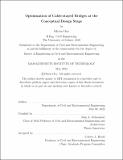| dc.description.abstract | Conceptual design of cable-stayed bridges, which defines the structure’s geometry and typology in the early stages of design, has significant influence on the structure’s efficiency, cost, aesthetics, and constructability. However, conventional design approaches for bridge design places greater emphasis on detailed structural analysis than conceptualization, resulting in designers being stuck in an iterative design loop with a structurally inefficient system.
This thesis looks at developing a user-friendly conceptual design tool in the form of efficiency curves, which relates the geometrical aspect ratio 𝐿/𝐻 of different cable-stayed typologies to its structural performance in terms of volume. By developing a parametric model in the Grasshopper environment, numerous design variables such as number of stay cables, span lengths, materiality, loading conditions, boundary conditions, and flexural rigidity in the towers and decks are able to be investigated and incorporated to obtain a more realistic behavior of the structurally indeterminate cable-stayed bridge.
A series of design curves are proposed for the harp, fan, web, and semi-fan cable configurations. The performance of the forms improves from the web, fan, semi-fan to harp configuration under symmetric loads, and under asymmetric loads, the fan configuration performs better than the harp configuration. Furthermore, since the design curves converge with increasing number of cables, the use of a truss analysis is sufficient for conceptual design, provided that the number of cables is adequate; this design approach, however, does not apply for the web configuration. Furthermore, a region of ’flatness’, equivalent to a range of 𝐿/𝐻 ratios that lies within a 10% variation of the optimum design solution, is proposed for different typologies, material, and boundary conditions. Overall, the web configuration has the most restrictive design curve out of all the typologies, with a very tight range of optimum 𝐿/𝐻 ratio. | |
